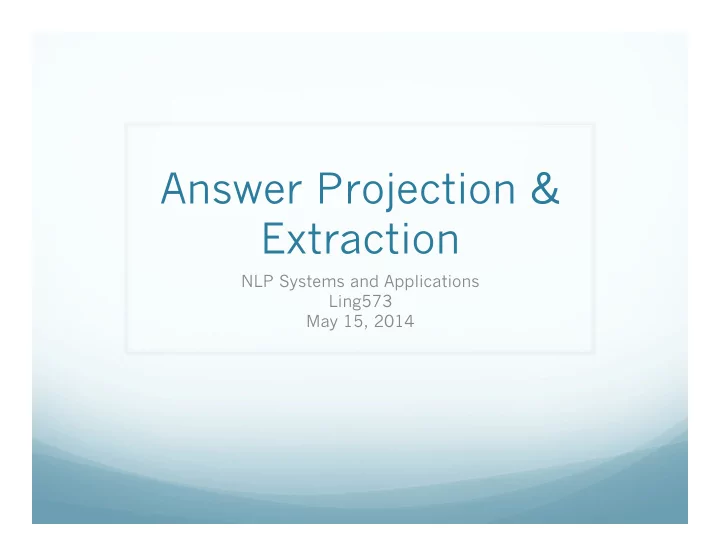

Answer Projection & Extraction NLP Systems and Applications Ling573 May 15, 2014
Roadmap Integrating Redundancy-based Answer Extraction Answer projection Answer reweighting Answer extraction as Sequence Tagging Answer candidate reranking Answer span extraction
Redundancy-Based Approaches & TREC Redundancy-based approaches: Exploit redundancy and large scale of web to Identify ‘easy’ contexts for answer extraction Identify statistical relations b/t answers and questions Frequently effective: More effective using Web as collection than TREC Issue: How integrate with TREC QA model? Requires answer string AND supporting TREC document
Answer Projection Idea: Project Web-based answer onto some TREC doc Find best supporting document in AQUAINT Baseline approach: (Concordia, 2007) Run query on Lucene index of TREC docs Identify documents where top-ranked answer appears Select one with highest retrieval score
Answer Projection Modifications: Not just retrieval status value Tf-idf of question terms No information from answer term E.g. answer term frequency (baseline: binary) Approximate match of answer term New weighting: Retrieval score x (frequency of answer + freq. of target) No major improvement: Selects correct document for 60% of correct answers
Answer Projection as Search Insight: (Mishne & De Rijk, 2005) Redundancy-based approach provides answer Why not search TREC collection after Web retrieval? Use web-based answer to improve query Alternative query formulations: Combinations Baseline: All words from Q & A Boost-Answer-N: All words, but weight Answer wds by N Boolean-Answer: All words, but answer must appear Phrases: All words, but group ‘phrases’ by shallow proc Phrase-Answer: All words, Answer words as phrase
Results Boost-Answer-N hurts! Topic drift to answer away from question Require answer as phrase, without weighting improves
Web-Based Boosting Create search engine queries from question Extract most redundant answers from search Augment Deep NLP approach Increase weight on TREC candidates that match Higher weight if higher frequency Intuition: QA answer search too focused on query terms Deep QA bias to matching NE type, syntactic class Reweighting improves Web-boosting improves significantly: 20%
Answering by Sequence Tagging Answer Extraction as Sequence Tagging with Tree Edit Distance Xuchen Yao, Benjamin Van Durme, Chris Callison-Burch, Peter Clark Intuition: Exploit dependency-level correspondence b/t Q & A Modeled as Tree Edit Distance over dependency parses Use to rank candidate answer sentences Use as features in sequence tagging for answer extr.
Intuition Answer extraction assumes correspondence b/t Q&A Many types of correspondence: Pattern-based cued on answer type Noisy-channel based surface word alignment Syntactic parallelism of constituent tree paths Semantic role parallelism of FrameNet frame elements Here, correspondence via dependency parse trees Similarity between question and answer candidate Tree Edit Distance: Total cost of best transformation from Q tree to D tree Transformation sequence: “edit script”
Answer to Question Edit
Tree Edit Distance Representation: Node: lemma, POS, dependency relation to parent (DEP) E.g., Mary è Mary/nnp/sub Basic edits: Insert or delete: Leaf node, whole subtree, other node Rename: node POS, DEP , or both Costs assigned to each operation Standard dynamic programming solution: least cost, opt.
Answer Candidate Ranking Goal: Given a question and set of candidate answer sents Return ranked answer list Approach: learn logistic regression model Features: Tree edit features from sentence to question 48 edit types: broken down by POS, DEP (similar to prior) WNSearch: TED, but allows alignment/renaming of lemmas that share WordNet relations: e.g. REN_..(sport, tennis) WNFeatures: # of words in each WN relation b/t question & answer
Answer Sentence Ranking Data: TREC QA Sentences w/non-stopword overlap Positive instances = pattern match Results: Competitive w/earlier systems: WN promising
Answer Extraction Option 1: Use tree alignment directly (like last class) Answer is content word (subtree) aligned to Q-word Issue: Limited, not tuned for this: F1: 31.4% Alternative: Build CRF sequence tagger Incorporate many features, including TED features
Answer Sequence Model Linear chain CRF model: BIO model Features over whole data Example sequence tagging:
Features “Chunking” features: Intuition: some chunks are more likely to be answers E.g. “in 90 days” vs “of silly” (in “kind of silly”) POS, NER, DEP features of current token Unigram, bigram, trigram contexts Fine, but obvious gap…. No relation to question! Question-type features: Combine q-type with above features (std. types) Perform question classification for what/which
Features II Tree Edit Features: Each token associated with edit operation from trace Deleted, renamed, or aligned E.g. Deleted term likely to be … answer Variety of features also tied to POS/NER/DEP Alignment features: Intuition: Answers often near aligned tokens Distance to nearest aligned word (integer) Also POS/NER/DEP feature of nearest aligned word
Answer Selection Run CRF tagging on high ranked answer sentences Assume all produce answers What do we do with multiple answers? Weighted voting: (cf. redundancy-based approach) Add partial overlap = #overlap/#words What if sentence produces NO answer? Insufficient prob mass for answer BI “Force” candidate: outlier span Threshold by multiple of Median Absolute Deviation MAD = median(|x – median(x)|), sequence x Weight score by 0.1
Forced Vote Example Sequence
Results All improve over baseline alignment approach Chunk/Q features ~10%; TED features + ~10%
Recommend
More recommend